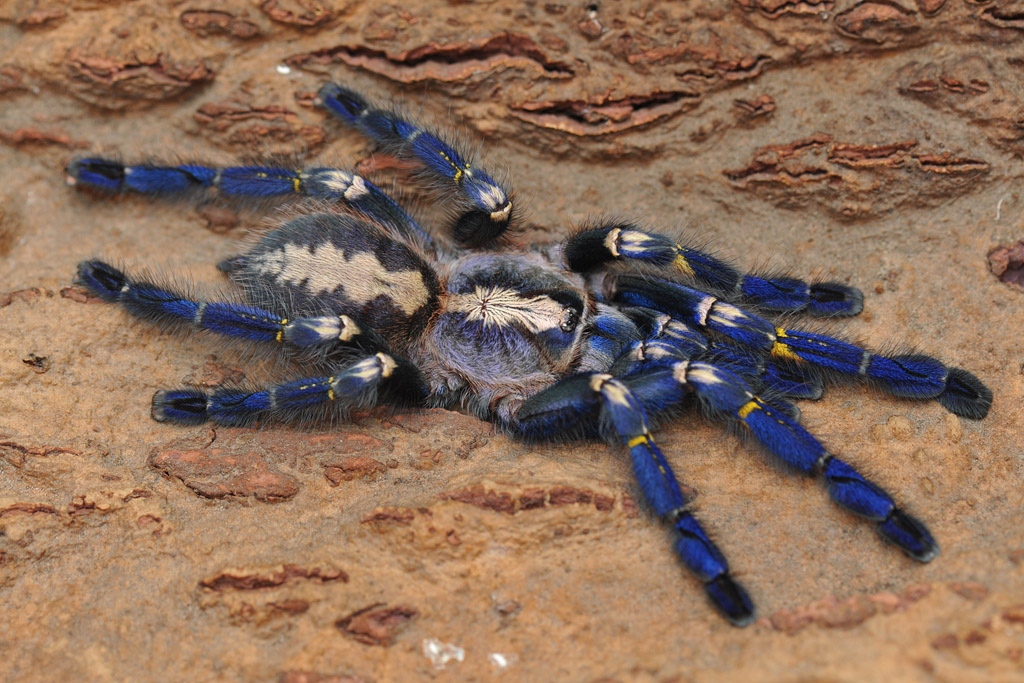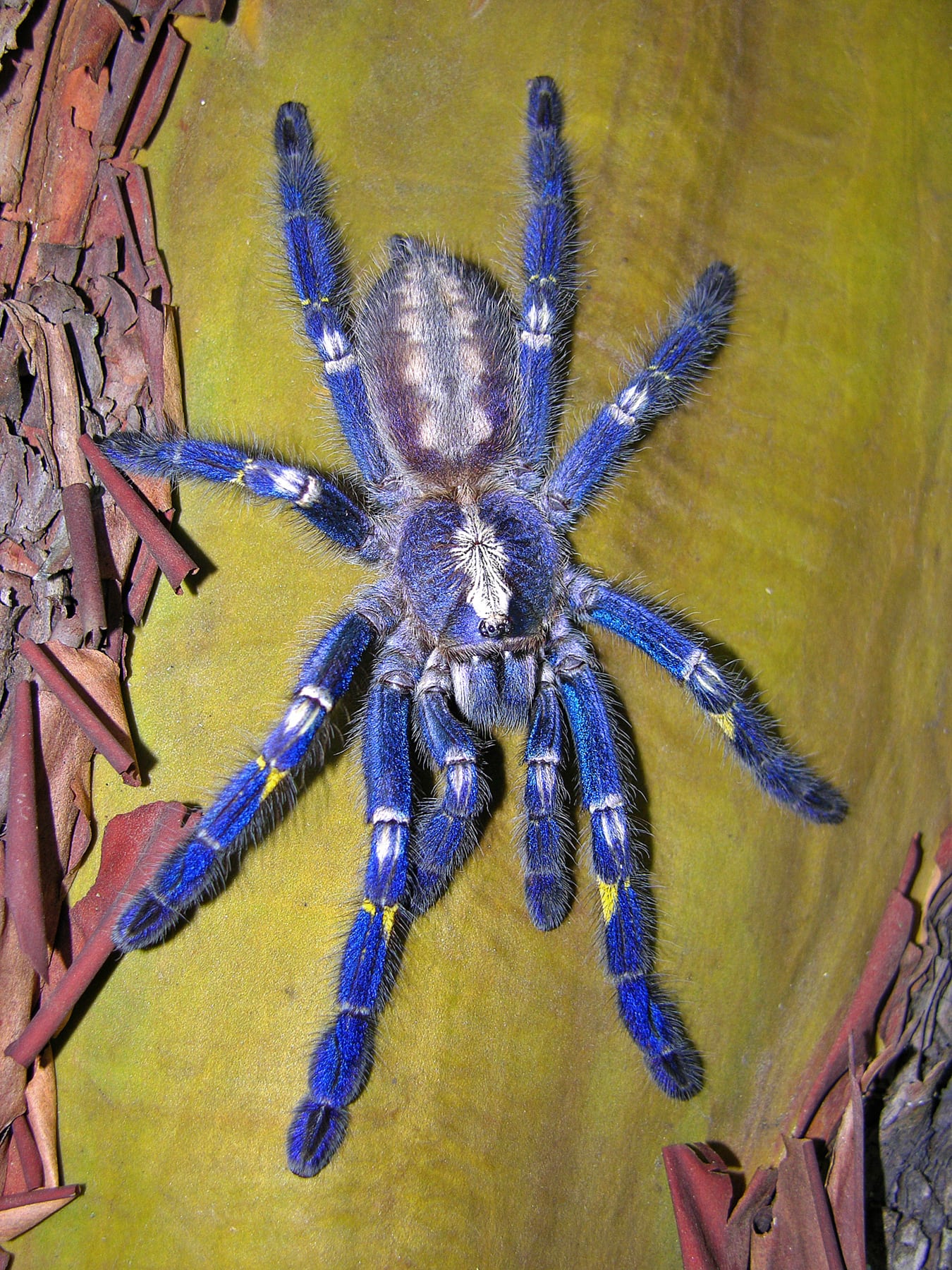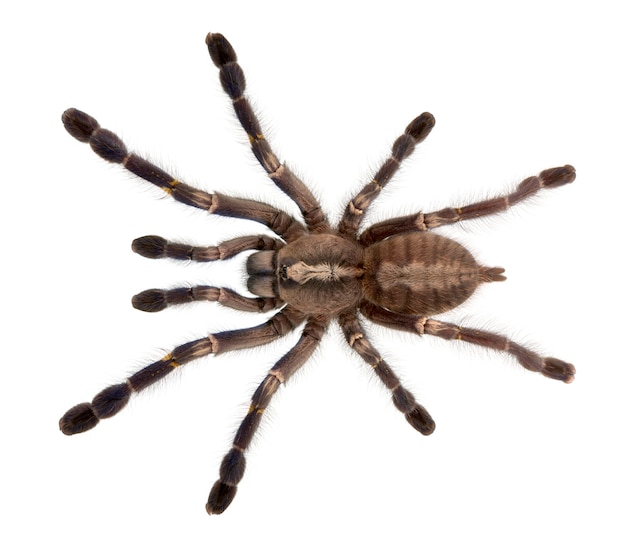
Poecilotheria metallica, native to India and Sri Lanka Poecilotheria
Poecilotheria metallica is an old world tarantula, which are tarantulas that are known for being more aggressive and possessing a painful bite. Of the old world tarantulas, this species has a bit of a nasty bite that isn't life threatening but is considered medically significant and can cause swelling, cramping, and persistent pain.

Poecilotheria metallica Adult Female Kyle Dickerson Flickr
The Poecilotheria metallica is an old-world tarantula species of the genus Poecilotheria, hailing from Southeast India. The spider has a leg span measuring 6 to 8 inches and a hairy body with a metallic blue hue. Poecilotheria metallicas are hardy and moderately easy to care for.

Poecilotheria metallica Mygale Ornementale Saphire en 2023 Mygale
The Gooty Saphire (Poecilotheria metallica) is a big, beautiful Tarantula that commands respect.Though it is a display animal rather than a pet, it is definitely worth having one… Time to learn about Gooty Saphire Tarantule care.

1.0 Poecilotheria metallica Poecilotheria Metallica, Arachnids Spiders
Poecilotheria Scientific Name Poecilotheria metallica Read our Complete Guide to Classification of Animals. Gooty Sapphire Tarantula Conservation Status Critically Endangered Gooty Sapphire Tarantula Locations Asia Gooty Sapphire Tarantula Facts Prey Flying insects, crickets Main Prey Flying insects Name Of Young

Tarantula spider, Poecilotheria Metallica, in front of white background
Poecilotheria metallica, commonly known as the Gooty sapphire ornamental tarantula, is a species of tarantula native to India. It is one of the most sought-after species of tarantula due to its striking coloration and unique patterning. This species is also known for its aggressive behavior and venomous bite.

Poecilotheria metallica, Metallica, Spider
Established in 1964, the IUCN Red List of Threatened Species has evolved to become the world's most comprehensive information source on the global conservation status of animal, fungi and plant species.

Pin on Inverts
Quick Facts Did You Know Scientific Classification Family: Theraphosidae Genus: Poecilotheria Spider Belonging to this Genus Gooty Sapphire Tarantula ( Poecilotheria metallica) Poecilotheria formosa Poecilotheria miranda Poecilotheria regalis Poecilotheria rufilata Poecilotheria striata Poecilotheria tigrinawesseli Poecilotheria fasciata
Poecilotheria metallica Arachnoboards
Poecilotheria metallica, also known as the peacock tarantula, is an Old World species of tarantula.. Poecilotheria metallica's behavior parallels that of many arboreal spiders. In the wild, P. metallica lives in holes of tall trees where it makes asymmetric funnel webs. The primary prey consists of various flying insects.

Female Poecilotheria metallica (Peacock Parachute Spider) in near
Poecilotheria metallica is a member of the spider family Theraphosidae and is primarily found in the warm, dry forests of south-central India. Their unique metallic blue coloration helps them blend into the environment. These spiders are considered beautiful and interesting, and their popularity as pets has grown over the last decade.

Premium Photo Tarantula spider, poecilotheria metallica, in front of
Poecilotheria metallica, a critically endangered species, is covered in an intricate geometric blue pattern; the burrow-building cobalt blue tarantula (Haplopelma lividum) is a slightly lighter.

T'kuvma Species Poecilotheria vittata Spider, Poecilotheria
Species: metallica Scientific Name Poecilotheria metallica Habitat: Distribution/Background The Gooty Sapphire Ornamental Tree Spider Poecilotheria metallica was described by Pocock in 1899. They originate from India, found at Andhra Pradesh, reserve forest between Nandyal and Giddalur, and Sri Lanka.

Poecilotheria Metallica, also known as the Gooty Sapphire Ornamental
Scientific Name Poecilotheria Metallica- originally designated Poecilotheria Metallica Pocock (1899). Characteristics of the Gooty Sapphire Tarantula This arboreal bird spider originated from the Southeast portion of India and is categorized as Old World. It was rediscovered in 2001, within the decimated forests between Nandyal and Giddalur.

De Spin Van De Tarantula, Poecilotheria Metallica Stock Foto
Gooty sapphire ornamental tree spider, Gooty tarantula, Gooty sapphire, peacock parachute spider, metallic tarantula, peacock tarantula. Lifespan. Males: 3 to 4 years. Females: 12 years. Distribution. India (Andhra Pradesh), Sri Lanka. Habitat. They are arboreal spiders, mostly living inside the holes of tall trees, in the dense deciduous forests.

Poecilotheria Metallica Poecilotheria metallica, Tarantula, Metallica
the sapphire ornamental tarantula ( Poecilotheria metallica) is a fast-growing Indian arboreal spider. They are a distinct member of the genus because of their striking blue-black coloration and relatively small adult size. Spiderlings grow into their blue coloration but show the same patterning.

Poecilotheria metallica, the Sapphire Gooty Ornamental Spider. A
The Gooty Sapphire Tarantula, scientifically known as the Poecilotheria Metallica is an Old World Tarantula that's native to India. This spider was first found in India in 1899 near the town of "Gooty", which is where the spider derives its name from. Interestingly enough, the spider was lost for a very long time, only to be rediscovered.

Beginner's Guide To Gooty Sapphire Ornamental (Poecilotheria metallica
Poecilotheria metallica goes by a variety of different common names; the Gooty Ornamental, Gooty Sapphire, and Peacock Parachute Spider to name just three.. Peocilotheria metallica is considered one of the most beautiful tarantulas in the world, combining the intricate patterning of other Poecilotheria species with a metallic blue sheen.. Interestingly, the Gooty Sapphire was originally.